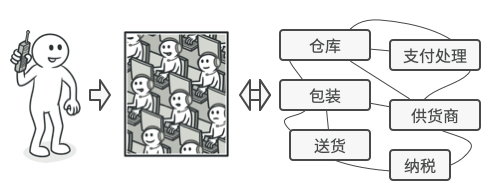外观模式
亦称: Facade
外观模式是一种结构型设计模式, 能为程序库、 框架或其他复杂类提供一个简单的接口。
问题:
假设必须在代码中使用某个复杂的库或框架中的众多对象。 正常情况下, 需要负责所有对象的初始化工作、 管理其依赖关系并按正确的顺序执行方法等。
最终, 程序中类的业务逻辑将与第三方类的实现细节紧密耦合, 使得理解和维护代码的工作很难进行。
解决:
外观类为包含许多活动部件的复杂子系统提供一个简单的接口。 与直接调用子系统相比, 外观提供的功能可能比较有限, 但它却包含了客户端真正关心的功能。
例如, 上传猫咪搞笑短视频到社交媒体网站的应用可能会用到专业的视频转换库, 但它只需使用一个包含 encode(filename, format)方法 (以文件名与文件格式为参数进行编码的方法) 的类即可。 在创建这个类并将其连接到视频转换库后, 就拥有了自己的第一个外观。

当通过电话给商店下达订单时, 接线员就是该商店的所有服务和部门的外观。 接线员为提供了一个同购物系统、 支付网关和各种送货服务进行互动的简单语音接口。

外观模式结构

外观 (Facade) 提供了一种访问特定子系统功能的便捷方式, 其了解如何重定向客户端请求, 知晓如何操作一切活动部件。
创建附加外观 (Additional Facade) 类可以避免多种不相关的功能污染单一外观, 使其变成又一个复杂结构。 客户端和其他外观都可使用附加外观。
复杂子系统 (Complex Subsystem) 由数十个不同对象构成。 如果要用这些对象完成有意义的工作, 必须深入了解子系统的实现细节, 比如按照正确顺序初始化对象和为其提供正确格式的数据。
子系统类不会意识到外观的存在, 它们在系统内运作并且相互之间可直接进行交互。
客户端 (Client) 使用外观代替对子系统对象的直接调用。

使用单个外观类隔离多重依赖的示例
可以创建一个封装所需功能并隐藏其他代码的外观类, 从而无需使全部代码直接与数十个框架类进行交互。 该结构还能将未来框架升级或更换所造成的影响最小化, 因为只需修改程序中外观方法的实现即可。
// 这里有复杂第三方视频转换框架中的一些类。我们不知晓其中的代码,因此无法
// 对其进行简化
class VideoFile
// ...
class OggCompressionCodec
// ...
class MPEG4CompressionCodec
// ...
class CodecFactory
// ...
class BitrateReader
// ...
class AudioMixer
// 为了将框架的复杂性隐藏在一个简单接口背后,我们创建了一个外观类。它是在
// 功能性和简洁性之间做出的权衡。
class VideoConverter is
method convert(filename, format):File is
file = new VideoFile(filename)
sourceCodec = new CodecFactory.extract(file)
if (format == "mp4")
destinationCodec = new MPEG4CompressionCodec()
else
destinationCodec = new OggCompressionCodec()
buffer = BitrateReader.read(filename, sourceCodec)
result = BitrateReader.convert(buffer, destinationCodec)
result = (new AudioMixer()).fix(result)
return new File(result)
// 应用程序的类并不依赖于复杂框架中成千上万的类。同样,如果决定更换框架,
// 那只需重写外观类即可。
class Application is
method main() is
convertor = new VideoConverter()
mp4 = convertor.convert("funny-cats-video.ogg", "mp4")
mp4.save()
适合场景
- 如果需要一个指向复杂子系统的直接接口, 且该接口的功能有限, 则可以使用外观模式**。
- 如果需要将子系统组织为多层结构, 可以使用外观。
- 创建外观来定义子系统中各层次的入口。 可以要求子系统仅使用外观来进行交互, 以减少子系统之间的耦合。
- 让我们回到视频转换框架的例子。 该框架可以拆分为两个层次: 音频相关和视频相关。 可以为每个层次创建一个外观, 然后要求各层的类必须通过这些外观进行交互。 这种方式看上去与[中介者]模式非常相似。
实现方式
- 考虑能否在现有子系统的基础上提供一个更简单的接口。 如果该接口能让客户端代码独立于众多子系统类, 那么的方向就是正确的。
- 在一个新的外观类中声明并实现该接口。 外观应将客户端代码的调用重定向到子系统中的相应对象处。 如果客户端代码没有对子系统进行初始化, 也没有对其后续生命周期进行管理, 那么外观必须完成此类工作。
- 如果要充分发挥这一模式的优势, 必须确保所有客户端代码仅通过外观来与子系统进行交互。 此后客户端代码将不会受到任何由子系统代码修改而造成的影响, 比如子系统升级后, 只需修改外观中的代码即可。
- 如果外观变得过于臃肿 可以考虑将其部分行为抽取为一个新的专用外观类。
与其他模式的关系
- 外观模式为现有对象定义了一个新接口, 适配器模式]则会试图运用已有的接口。 适配器通常只封装一个对象, 外观通常会作用于整个对象子系统上。
- 当只需对客户端代码隐藏子系统创建对象的方式时, 可以使用抽象工厂模式来代替外观
- 享元模式展示了如何生成大量的小型对象, 外观]则展示了如何用一个对象来代表整个子系统。
- 外观和中介者的职责类似: 它们都尝试在大量紧密耦合的类中组织起合作。
- 外观为子系统中的所有对象定义了一个简单接口, 但是它不提供任何新功能。 子系统本身不会意识到外观的存在。 子系统中的对象可以直接进行交流。
- 中介者将系统中组件的沟通行为中心化。 各组件只知道中介者对象, 无法直接相互交流。
- [外观]类通常可以转换为单例模类, 因为在大部分情况下一个外观对象就足够了。
go语言实现
人们很容易低估使用信用卡订购披萨时幕后工作的复杂程度。 在整个过程中会有不少的子系统发挥作用。 下面是其中的一部分:
- 检查账户
- 检查安全码
- 借记/贷记余额
- 账簿录入
- 发送消息通知
在如此复杂的系统中, 可以说是一步错步步错, 很容易就会引发大的问题。 这就是为什么我们需要外观模式, 让客户端可以使用一个简单的接口来处理众多组件。 客户端只需要输入卡片详情、 安全码、 支付金额以及操作类型即可。 外观模式会与多种组件进一步地进行沟通, 而又不会向客户端暴露其内部的复杂性。
package main
import (
"fmt"
"log"
)
//复杂子系统1--检查账户
type account struct {
name string
}
func newAccount(accountName string) *account {
return &account{
name: accountName,
}
}
func (a *account) checkAccount(accountName string) error {
if a.name != accountName {
return fmt.Errorf("Account Name is incorrect")
}
fmt.Println("Account Verified")
return nil
}
//复杂子系统2--检查安全码
type securityCode struct {
code int
}
func newSecurityCode(code int) *securityCode {
return &securityCode{
code: code,
}
}
func (s *securityCode) checkCode(incomingCode int) error {
if s.code != incomingCode {
return fmt.Errorf("Security Code is incorrect")
}
fmt.Println("SecurityCode Verified")
return nil
}
//复杂子系统3--借记/贷记余额
type wallet struct {
balance int
}
func newWallet() *wallet {
return &wallet{
balance: 0,
}
}
func (w *wallet) creditBalance(amount int) {
w.balance += amount
fmt.Println("Wallet balance added successfully")
return
}
func (w *wallet) debitBalance(amount int) error {
if w.balance < amount {
return fmt.Errorf("Balance is not sufficient")
}
fmt.Println("Wallet balance is Sufficient")
w.balance = w.balance - amount
return nil
}
//复杂子系统4--账簿录入
type ledger struct {
}
func (s *ledger) makeEntry(accountID, txnType string, amount int) {
fmt.Printf("Make ledger entry for accountId %s with txnType %s for amount %d\n", accountID, txnType, amount)
return
}
//复杂子系统5--发送消息通知
type notification struct {
}
func (n *notification) sendWalletCreditNotification() {
fmt.Println("Sending wallet credit notification")
}
func (n *notification) sendWalletDebitNotification() {
fmt.Println("Sending wallet debit notification")
}
//外观模式类
type walletFacade struct {
account *account
wallet *wallet
securityCode *securityCode
notification *notification
ledger *ledger
}
func newWalletFacade(accountID string, code int) *walletFacade {
fmt.Println("Starting create account")
walletFacacde := &walletFacade{
account: newAccount(accountID),
securityCode: newSecurityCode(code),
wallet: newWallet(),
notification: ¬ification{},
ledger: &ledger{},
}
fmt.Println("Account created")
return walletFacacde
}
func (w *walletFacade) addMoneyToWallet(accountID string, securityCode int, amount int) error {
fmt.Println("Starting add money to wallet")
err := w.account.checkAccount(accountID)
if err != nil {
return err
}
err = w.securityCode.checkCode(securityCode)
if err != nil {
return err
}
w.wallet.creditBalance(amount)
w.notification.sendWalletCreditNotification()
w.ledger.makeEntry(accountID, "credit", amount)
return nil
}
func (w *walletFacade) deductMoneyFromWallet(accountID string, securityCode int, amount int) error {
fmt.Println("Starting debit money from wallet")
err := w.account.checkAccount(accountID)
if err != nil {
return err
}
err = w.securityCode.checkCode(securityCode)
if err != nil {
return err
}
err = w.wallet.debitBalance(amount)
if err != nil {
return err
}
w.notification.sendWalletDebitNotification()
w.ledger.makeEntry(accountID, "credit", amount)
return nil
}
func main() {
walletFacade := newWalletFacade("abc", 1234)
err := walletFacade.addMoneyToWallet("abc", 1234, 10)
if err != nil {
log.Fatalf("Error: %s\n", err.Error())
}
fmt.Println()
err = walletFacade.deductMoneyFromWallet("abc", 1234, 5)
if err != nil {
log.Fatalf("Error: %s\n", err.Error())
}
}